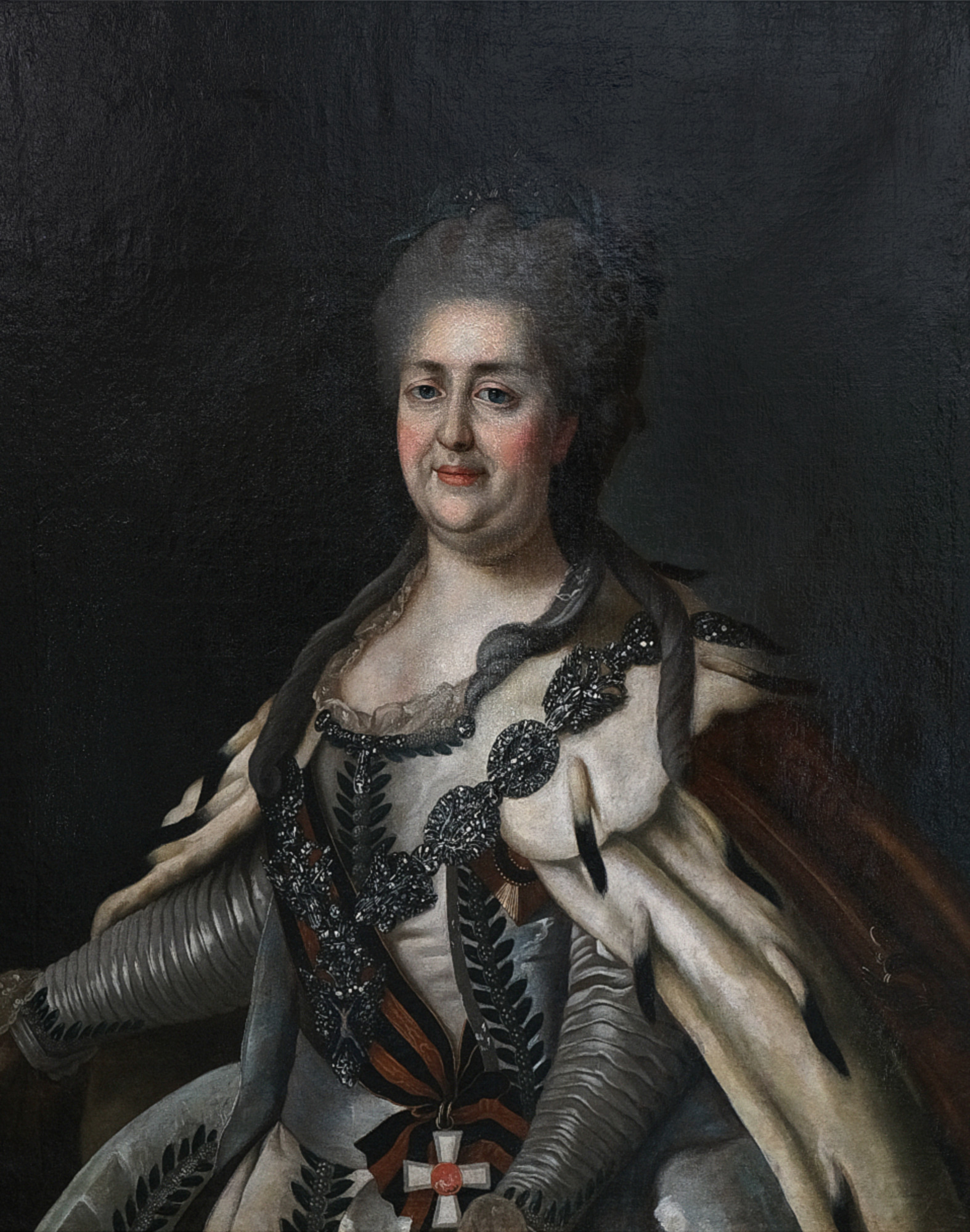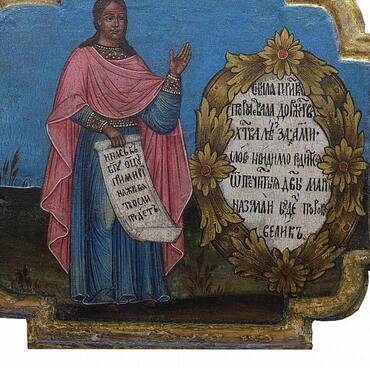The portrait of Empress Catherine II is modeled on a painting by the famous artist Fyodor Rokotov.
The sign of the highest order of the Russian Empire — St. Andrew the Apostle — stands out on the chest of the Empress. It looks like a blue cross on top of a black double-headed eagle with three crowns. Crucified Saint Apostle Andrew is depicted on the cross. The ornate order chain consists of 3 types of links that alternate with each other. One of the links depicts the coat of arms of the Russian Empire in the form of a double-headed eagle.
A black and orange ribbon with a large white cross descends from the right shoulder — this is the badge of the 1st Class Order of St. George. The star of this award is visible on the right side of the ruler’s dress, it is slightly covered with an ermine mantle.
Catherine II herself established the Order of St. George. This happened around 1769. The status of the Empress allowed her to immediately become a St. George Dame of the 1st Class Order. Fyodor Rokotov painted several portraits of her with a ribbon. The Empress liked them, and therefore they were recommended as a model for other artists. At that time, portraits of the empress were in great demand both in state institutions and in rich houses, so painters often took a recognized copy as a model and painted their works from it.
The portrait from the museum’s collection was executed by an unknown master, but professionalism indicates that he could have been a metropolitan painter. The author captured Catherine II with her famous half-smile. He managed to reliably convey the texture of fabrics and other materials: the shimmer and shine of silk, the softness and smoothness of fur.
Under Catherine II’s reign, the empire was flourishing. Her decree “On making special plans for each province for all cities, their buildings and streets”, dated 1763, marked the beginning of the reconstruction of medieval Russian cities. The settlements affected by the fire were the first to be rebuilt according to the new plans.
Kargopol was among them. In July 1765, a fire destroyed three-quarters of the town buildings: 294 houses, 9 churches, a Gostiny Dvor with the haberdashery, tannery, bread and meat rows, wine shops, storerooms and barns with goods, as well as tanneries, an industrial beer brewery and customs. The resolution of Catherine II on the Decree of the Senate “On the rebuilding of the city of Kargopol” provided not only for the construction of state institutions and churches but also a loan for the construction of private houses. Therefore, the name of the Empress is especially memorable to the townspeople.
The architects restored the town according to a regular linear plan: the streets ran along the river and at right angles to them. One of them was named after the empress — Ekaterininskaya. Today it is Lenin Street.
The sign of the highest order of the Russian Empire — St. Andrew the Apostle — stands out on the chest of the Empress. It looks like a blue cross on top of a black double-headed eagle with three crowns. Crucified Saint Apostle Andrew is depicted on the cross. The ornate order chain consists of 3 types of links that alternate with each other. One of the links depicts the coat of arms of the Russian Empire in the form of a double-headed eagle.
A black and orange ribbon with a large white cross descends from the right shoulder — this is the badge of the 1st Class Order of St. George. The star of this award is visible on the right side of the ruler’s dress, it is slightly covered with an ermine mantle.
Catherine II herself established the Order of St. George. This happened around 1769. The status of the Empress allowed her to immediately become a St. George Dame of the 1st Class Order. Fyodor Rokotov painted several portraits of her with a ribbon. The Empress liked them, and therefore they were recommended as a model for other artists. At that time, portraits of the empress were in great demand both in state institutions and in rich houses, so painters often took a recognized copy as a model and painted their works from it.
The portrait from the museum’s collection was executed by an unknown master, but professionalism indicates that he could have been a metropolitan painter. The author captured Catherine II with her famous half-smile. He managed to reliably convey the texture of fabrics and other materials: the shimmer and shine of silk, the softness and smoothness of fur.
Under Catherine II’s reign, the empire was flourishing. Her decree “On making special plans for each province for all cities, their buildings and streets”, dated 1763, marked the beginning of the reconstruction of medieval Russian cities. The settlements affected by the fire were the first to be rebuilt according to the new plans.
Kargopol was among them. In July 1765, a fire destroyed three-quarters of the town buildings: 294 houses, 9 churches, a Gostiny Dvor with the haberdashery, tannery, bread and meat rows, wine shops, storerooms and barns with goods, as well as tanneries, an industrial beer brewery and customs. The resolution of Catherine II on the Decree of the Senate “On the rebuilding of the city of Kargopol” provided not only for the construction of state institutions and churches but also a loan for the construction of private houses. Therefore, the name of the Empress is especially memorable to the townspeople.
The architects restored the town according to a regular linear plan: the streets ran along the river and at right angles to them. One of them was named after the empress — Ekaterininskaya. Today it is Lenin Street.



